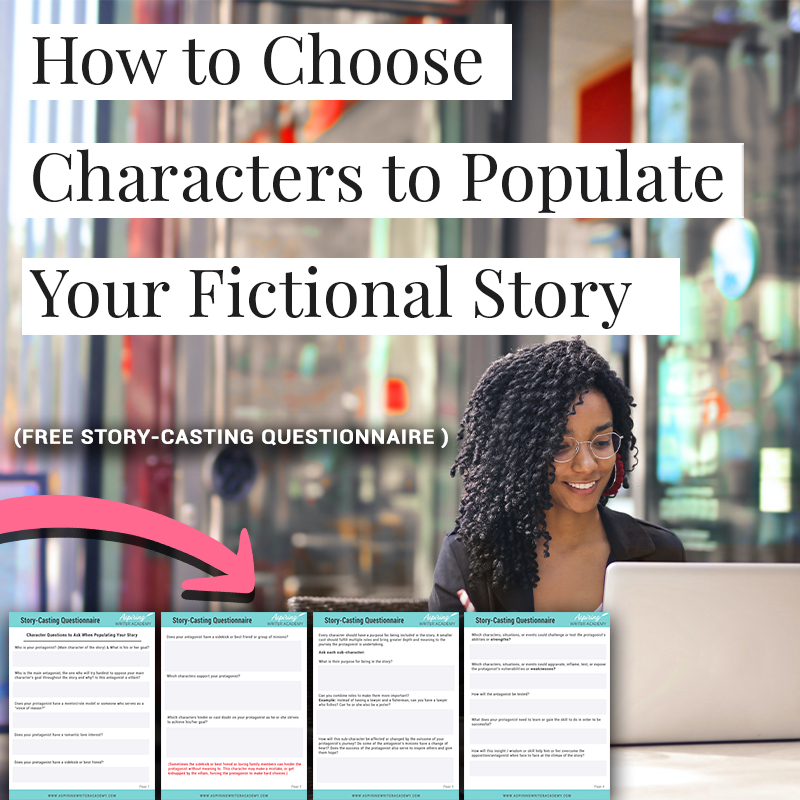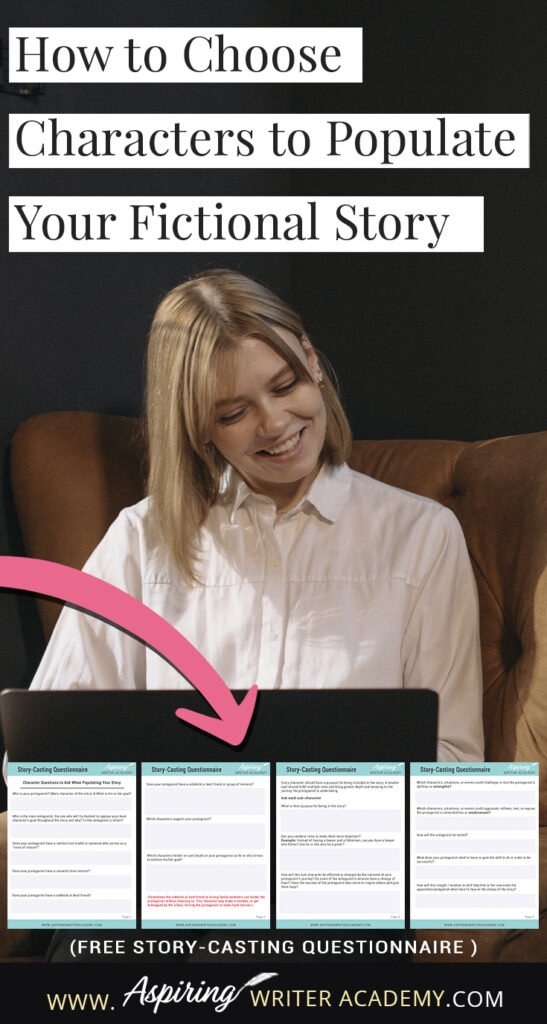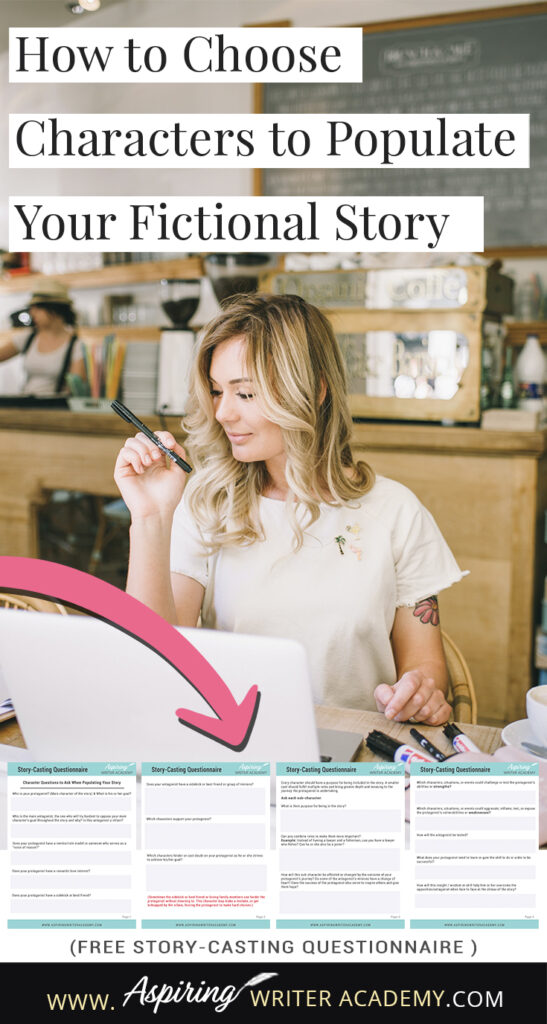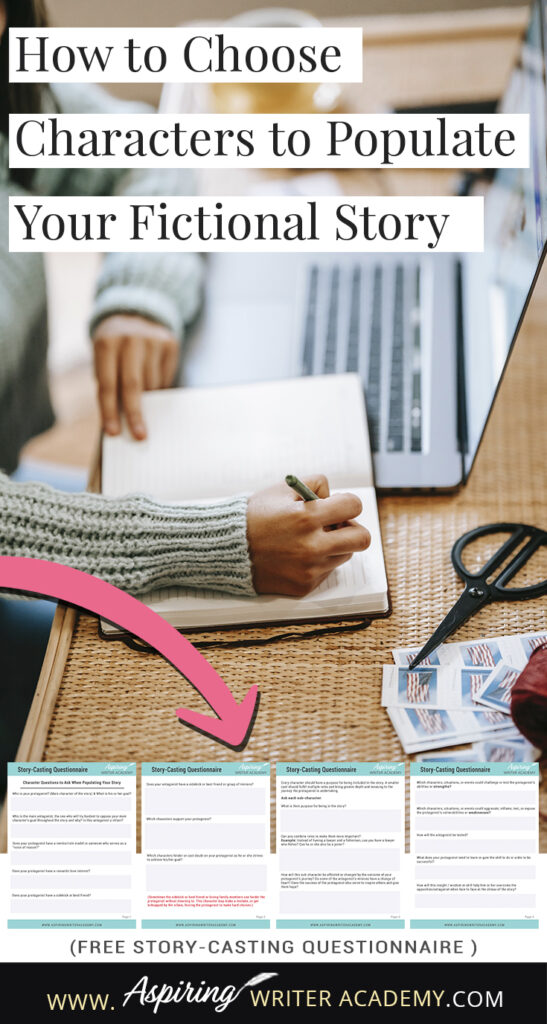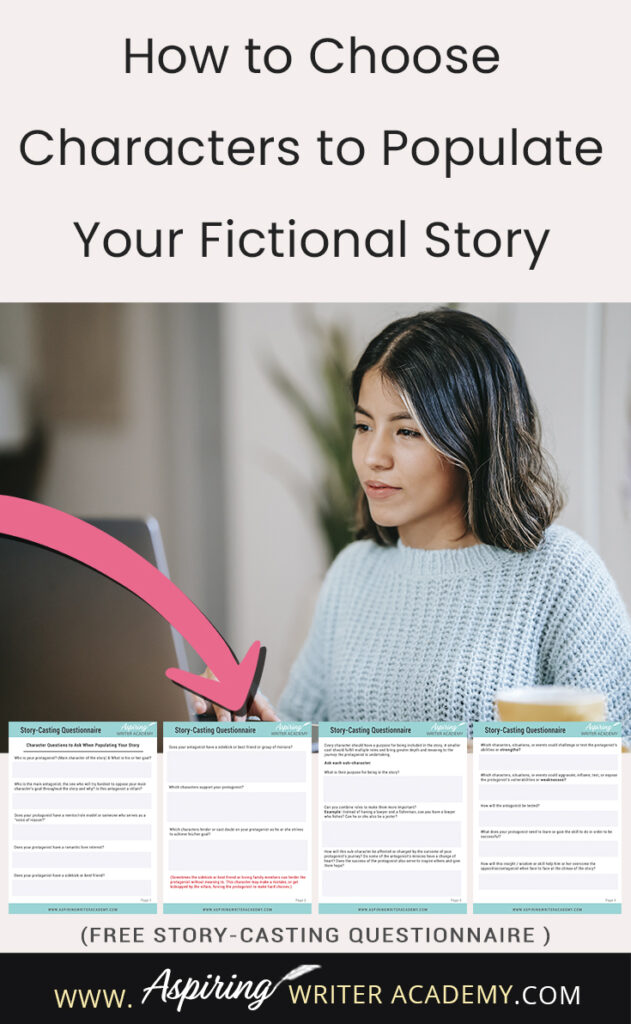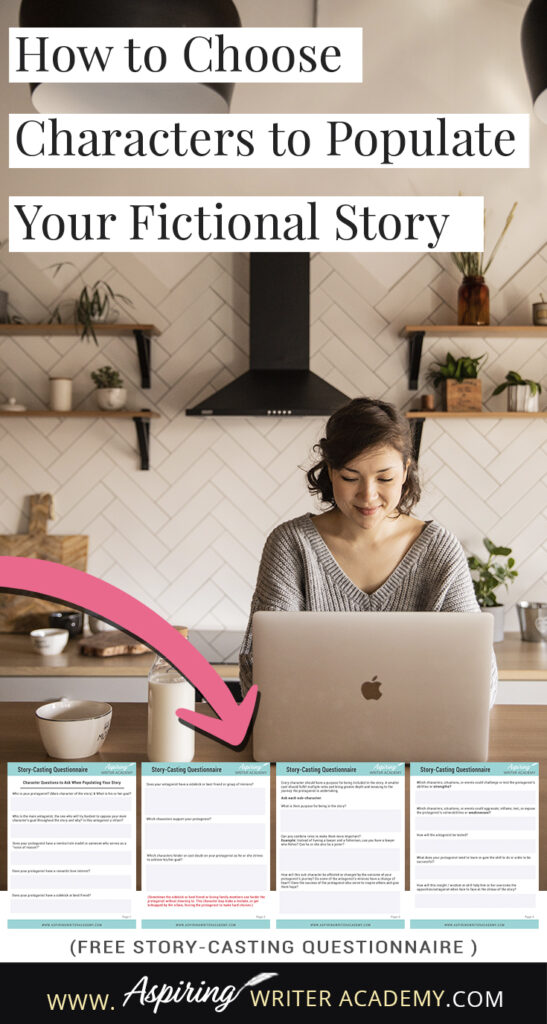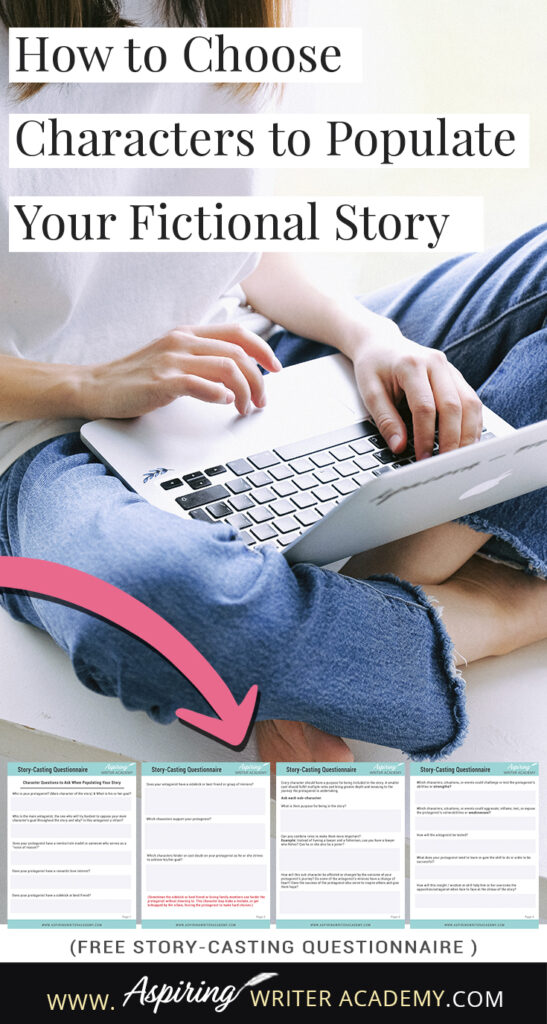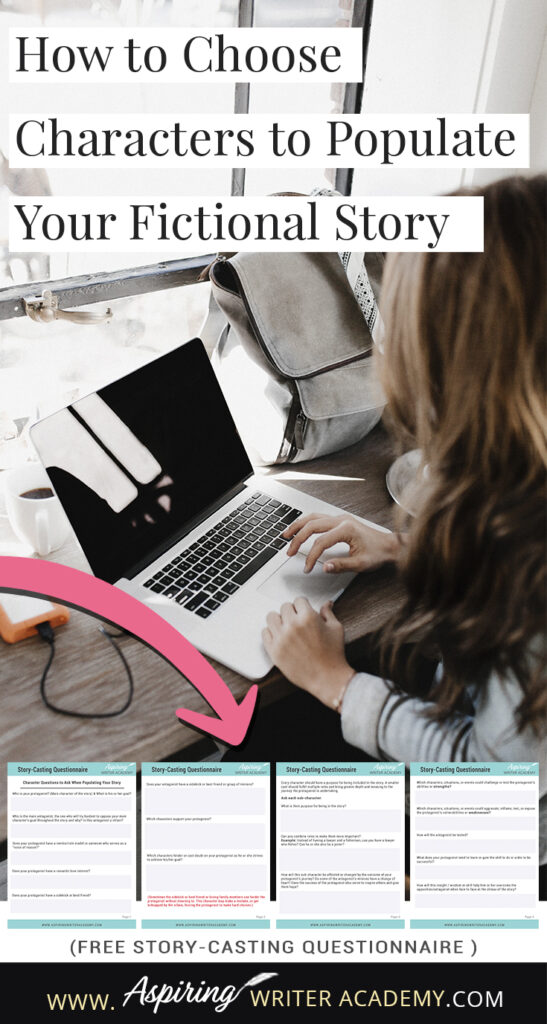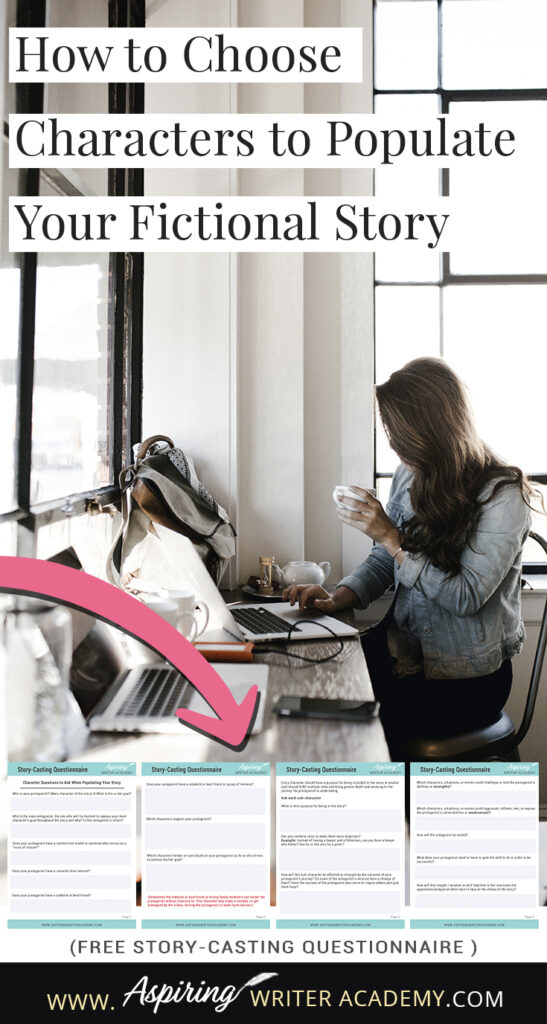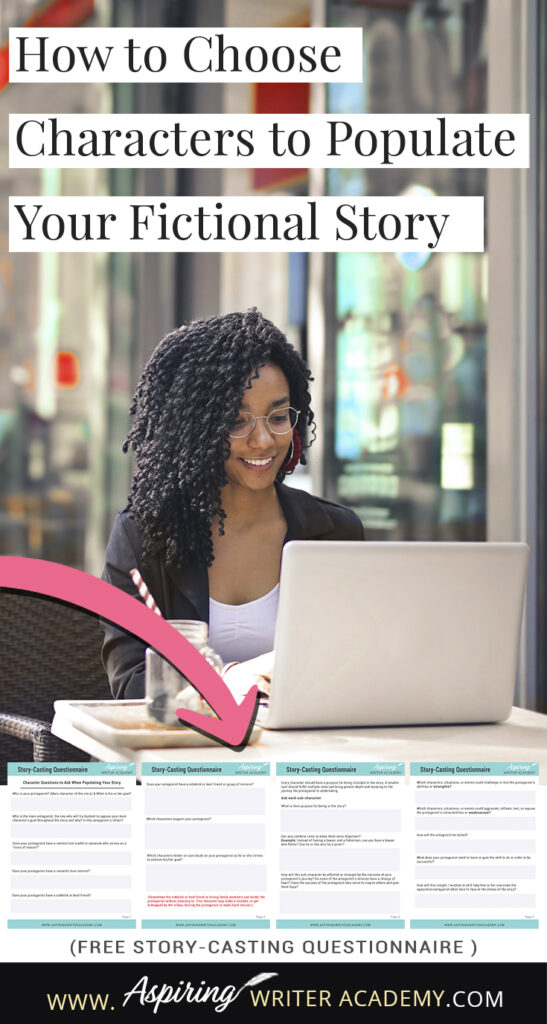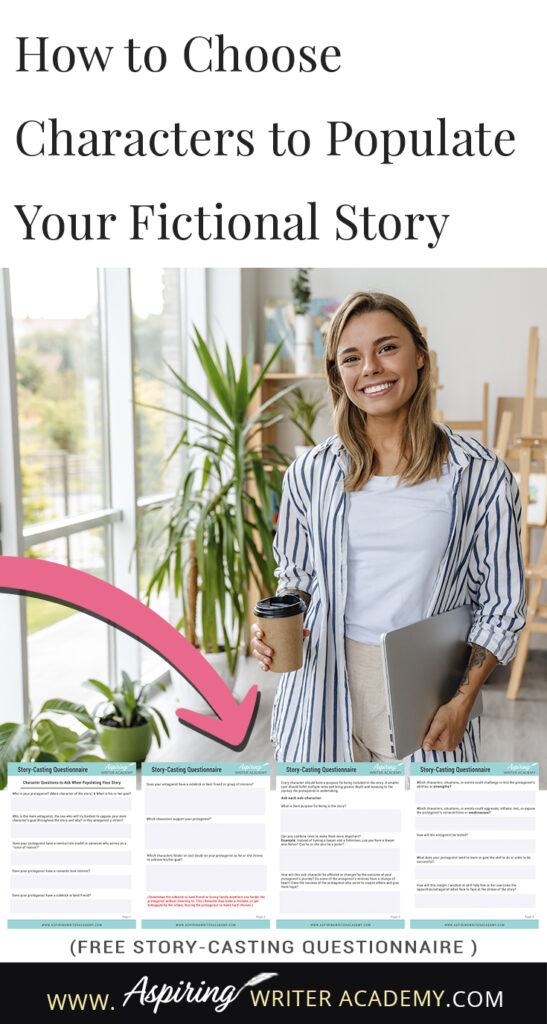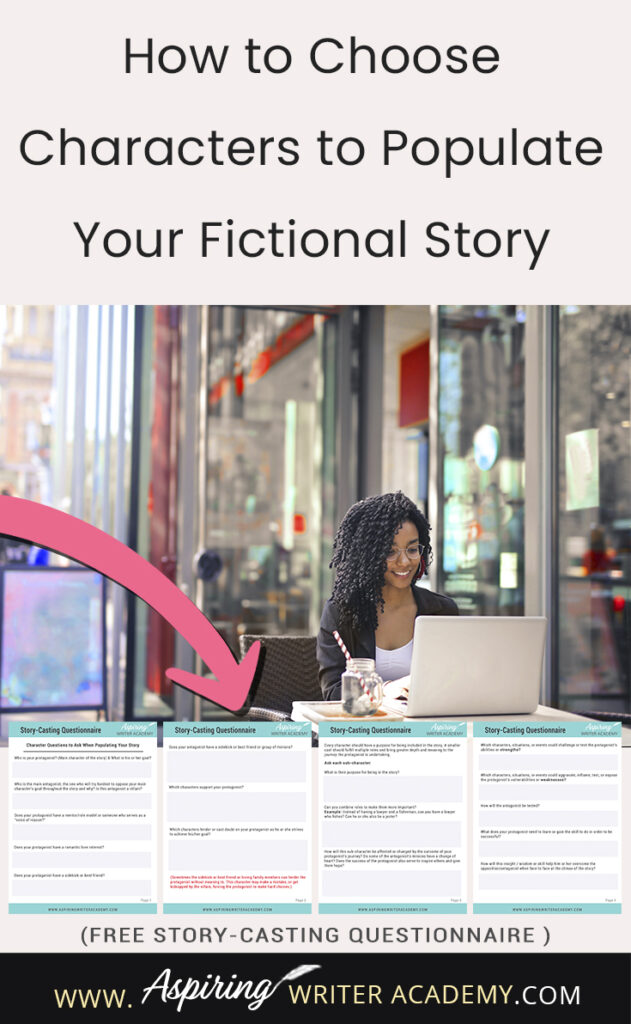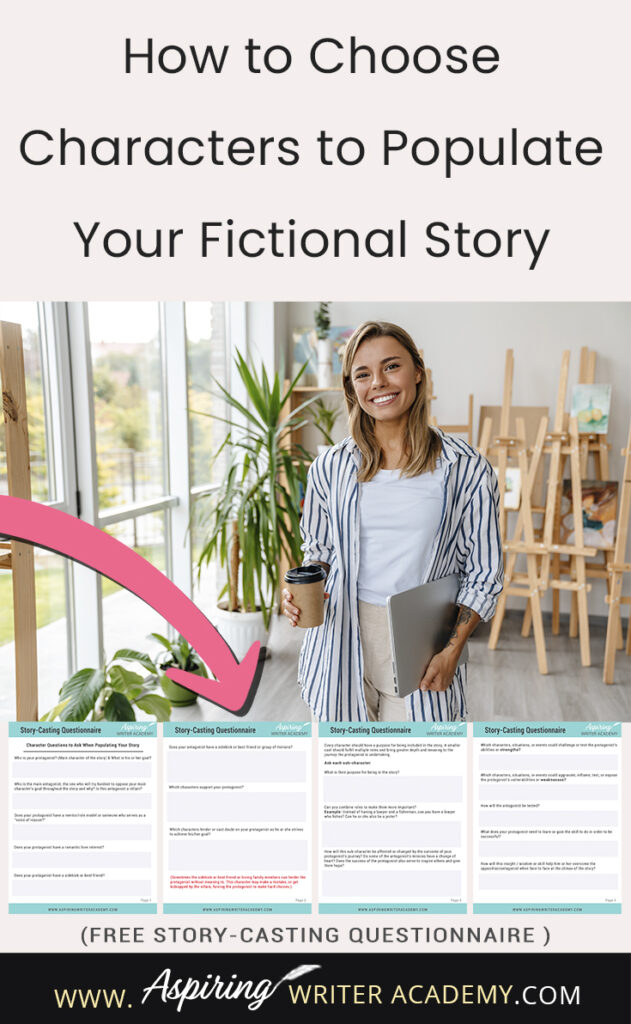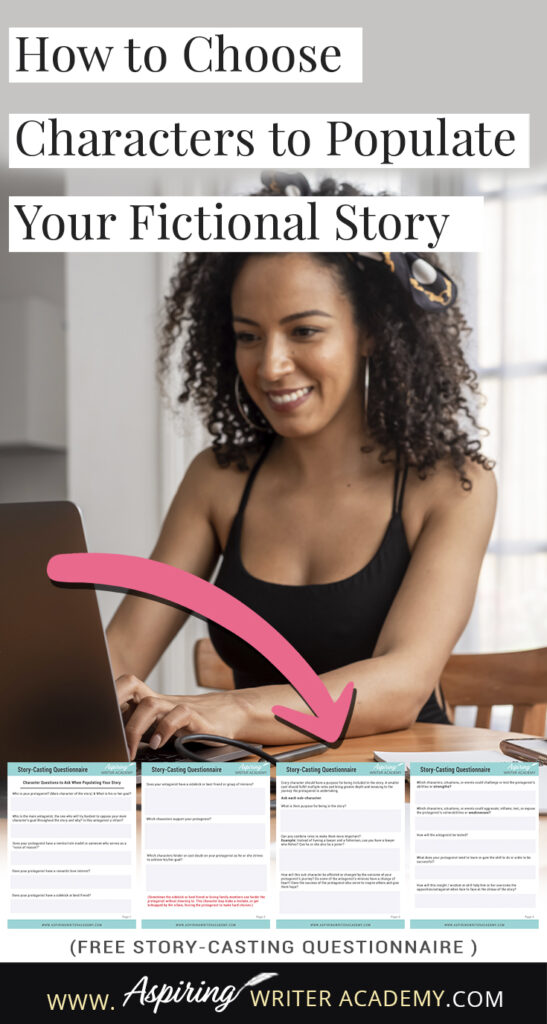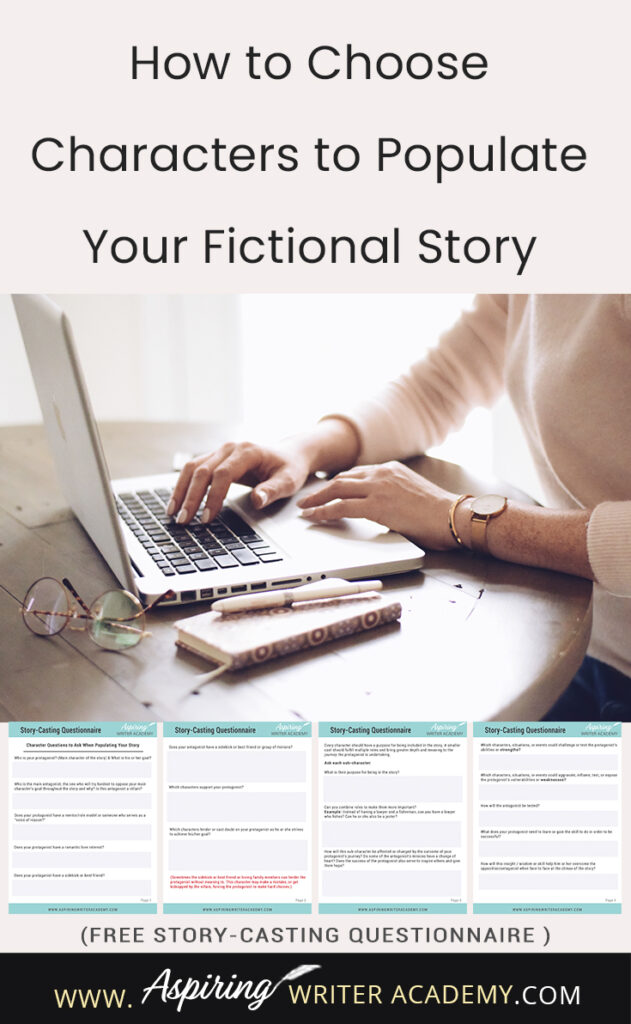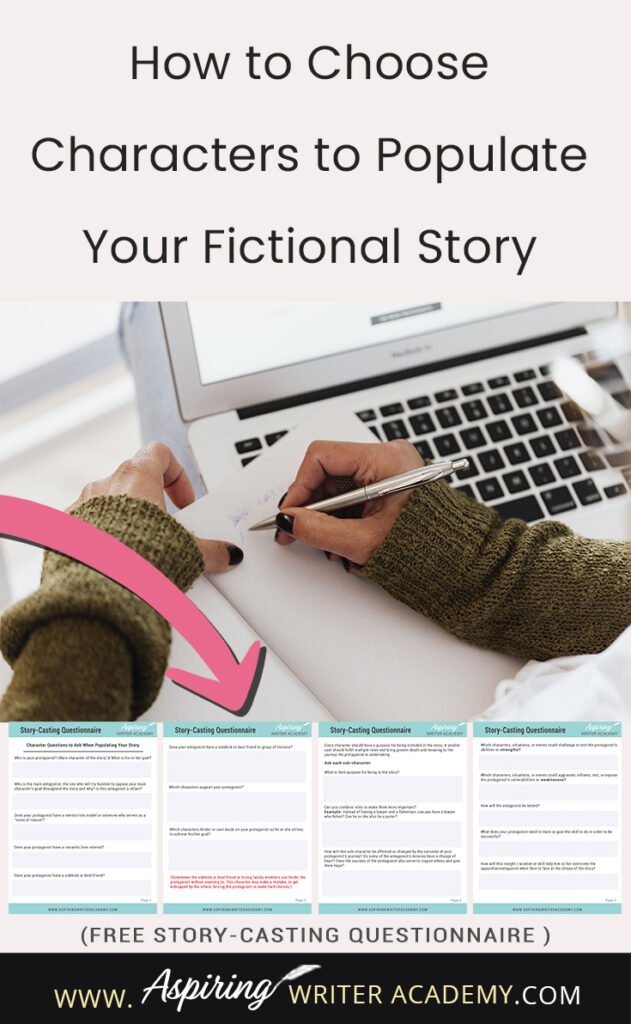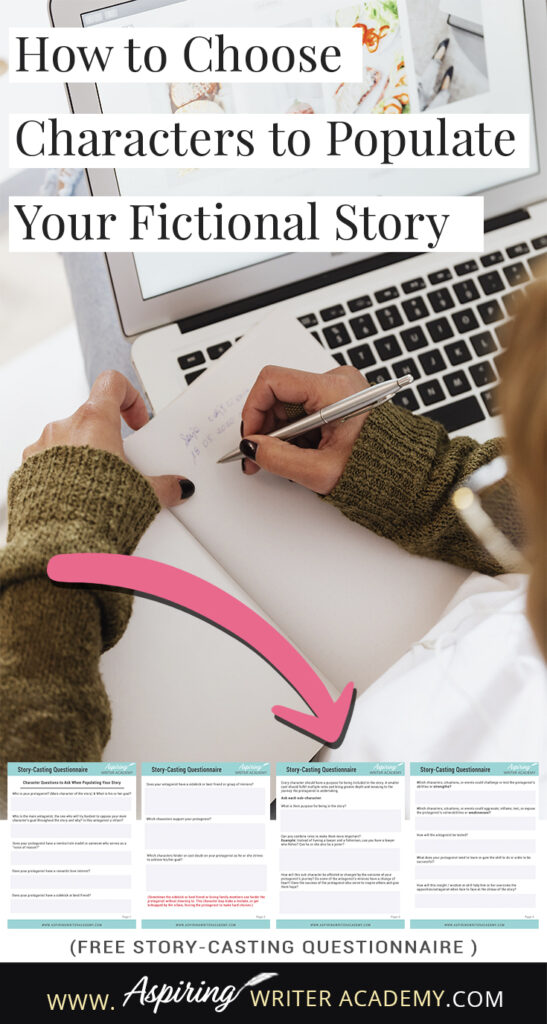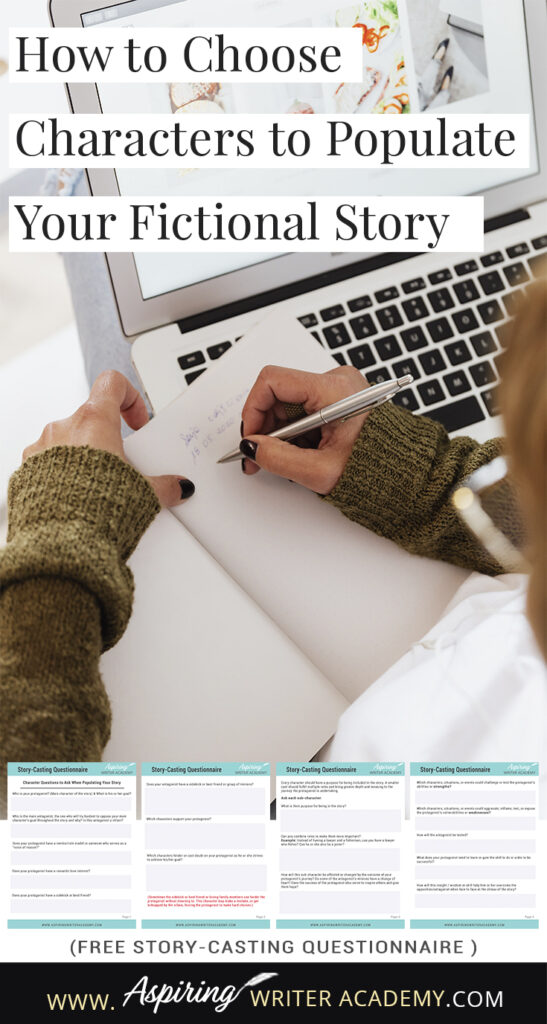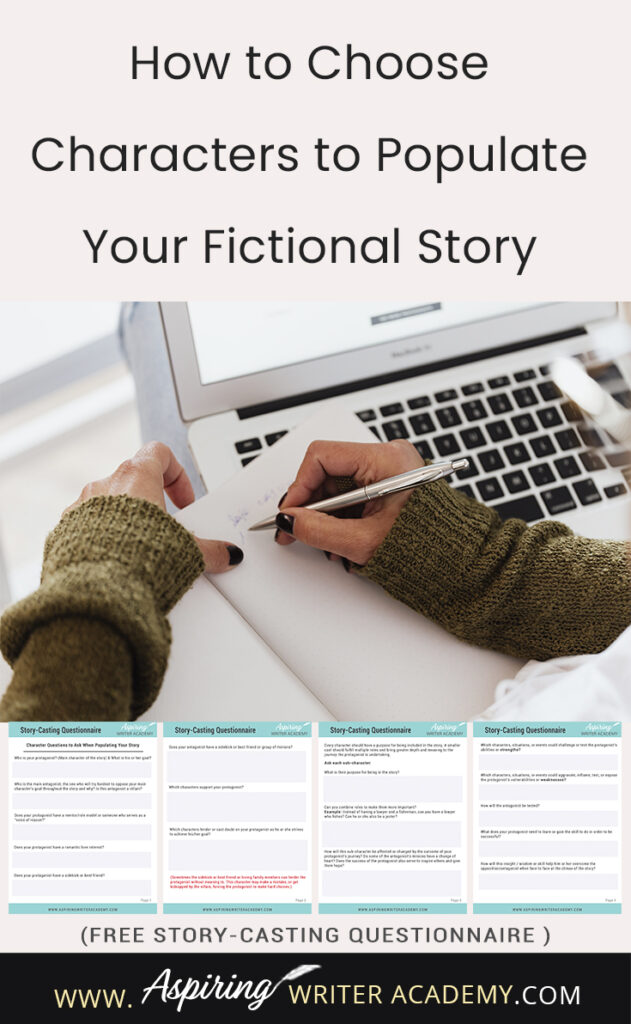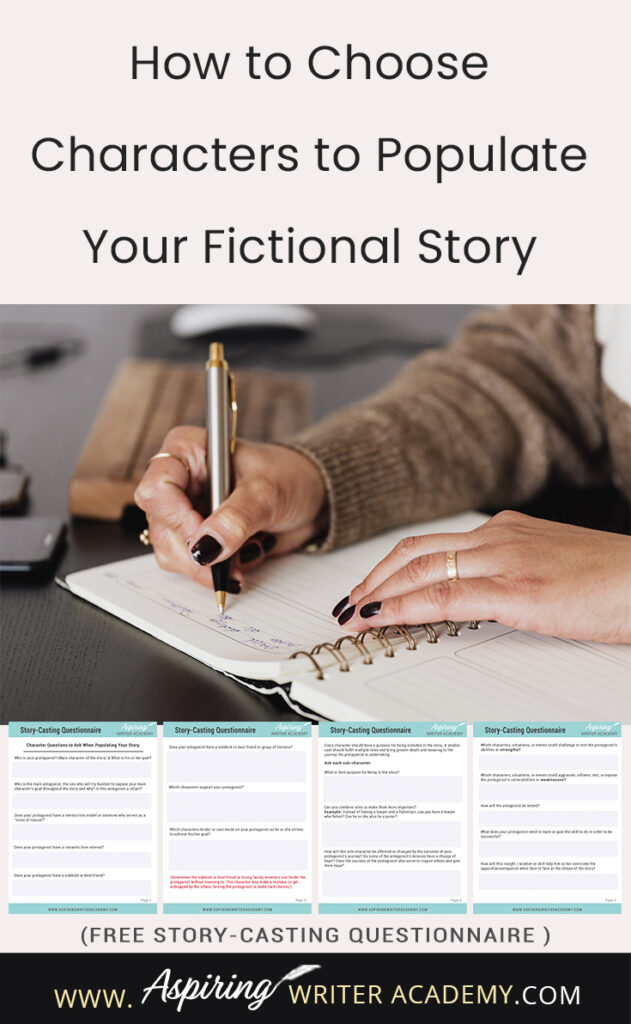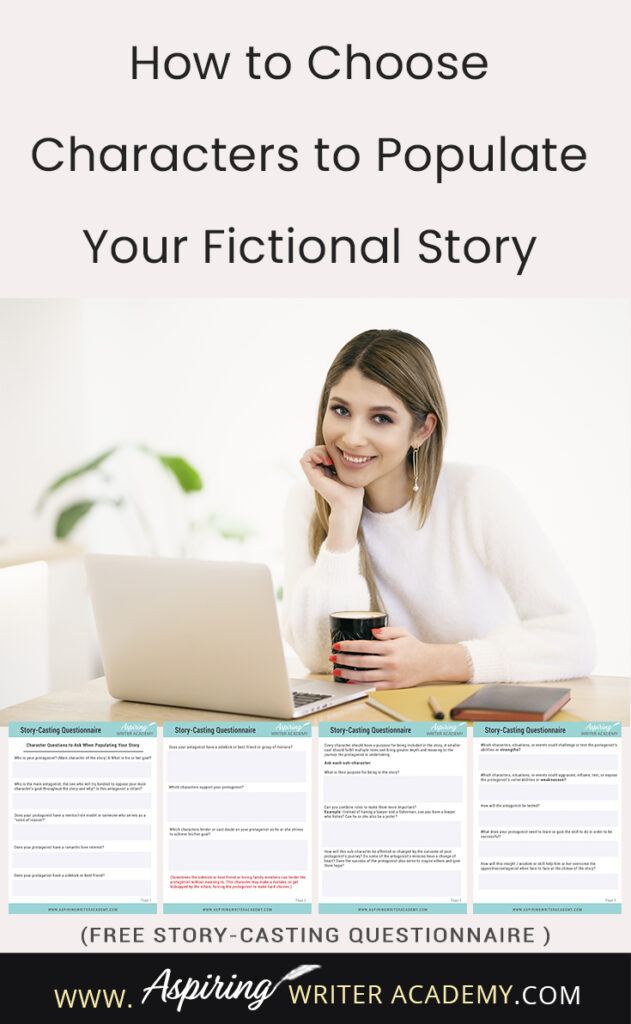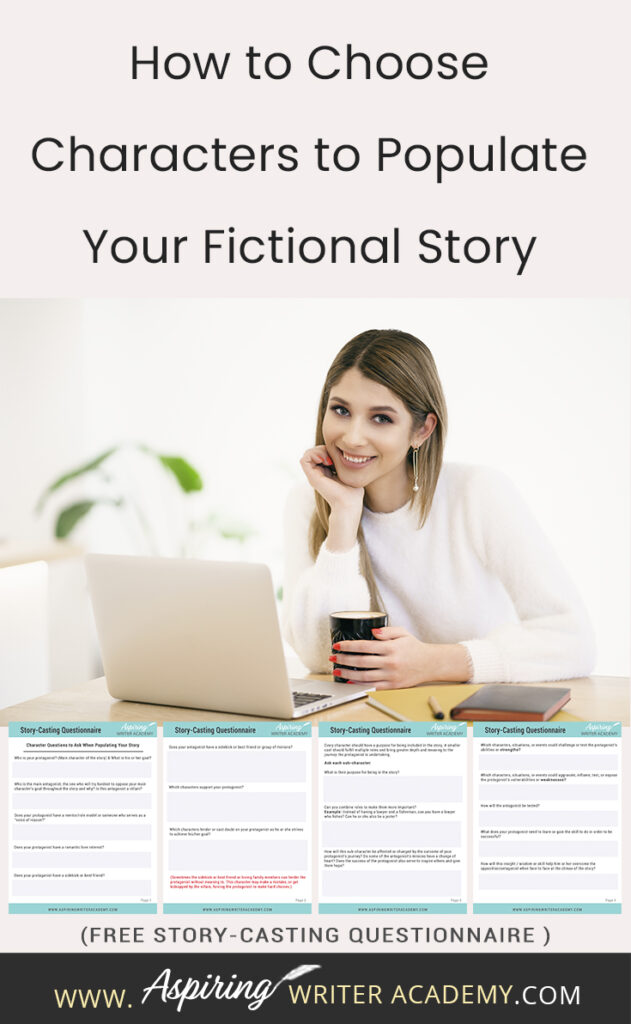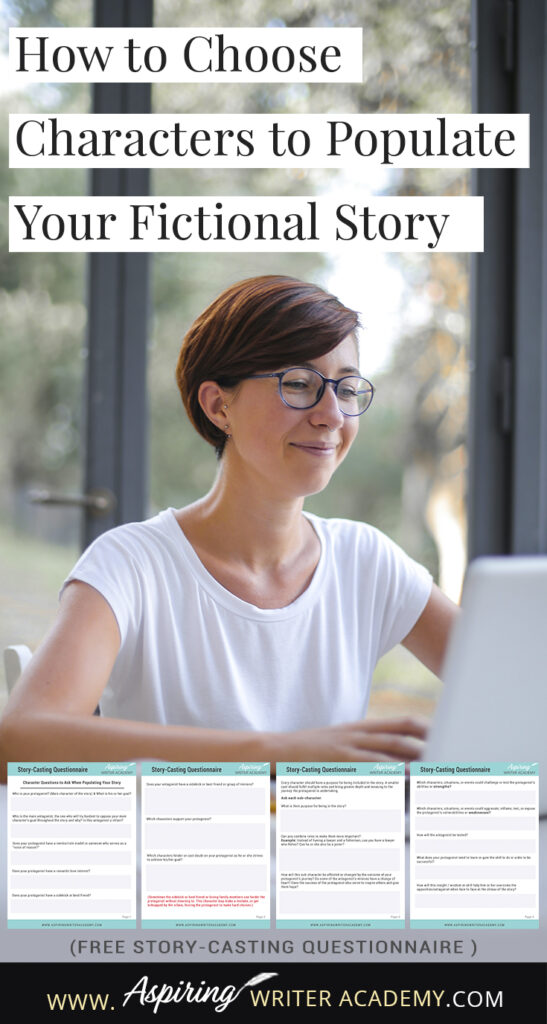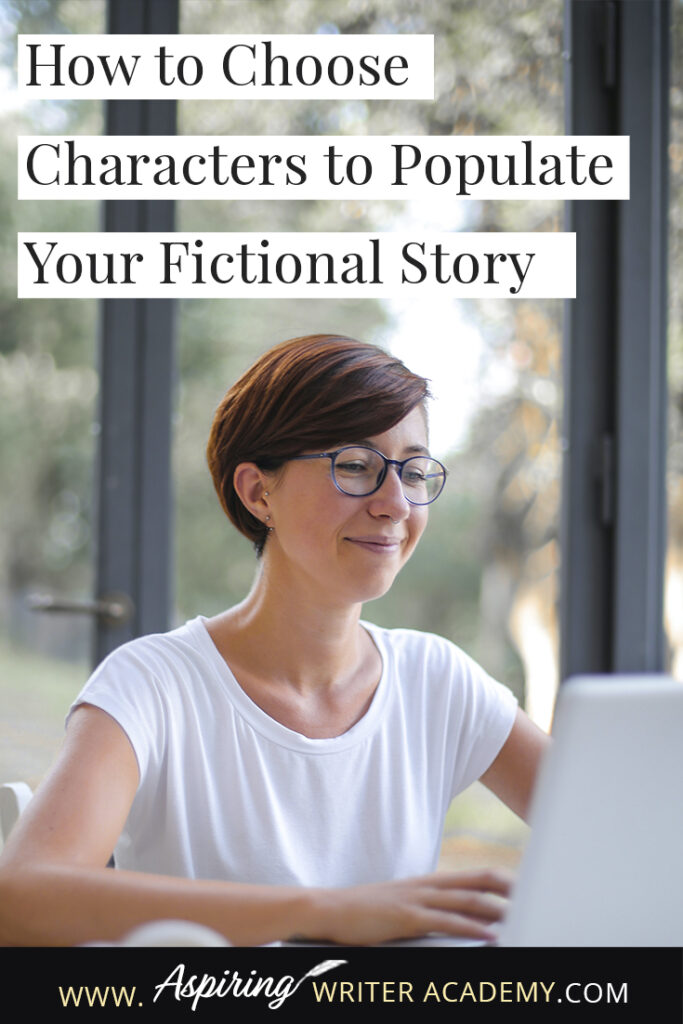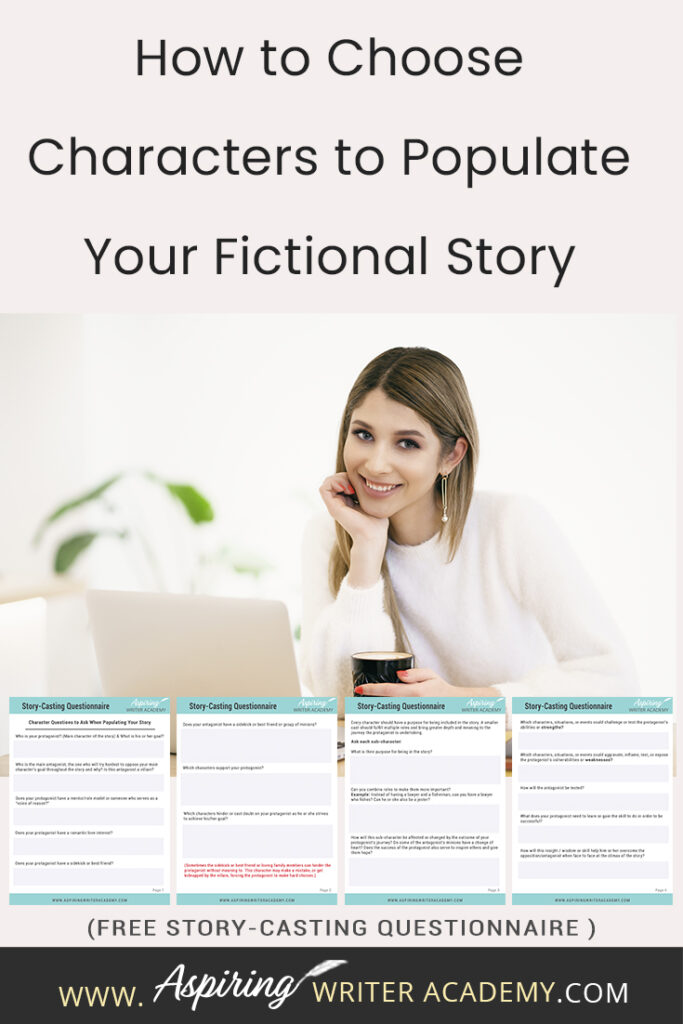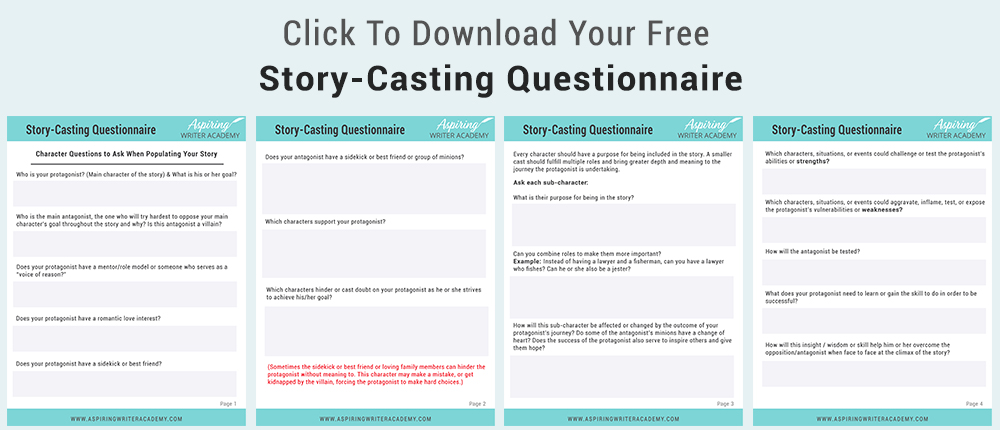How to Choose Characters to Populate Your Fictional Story
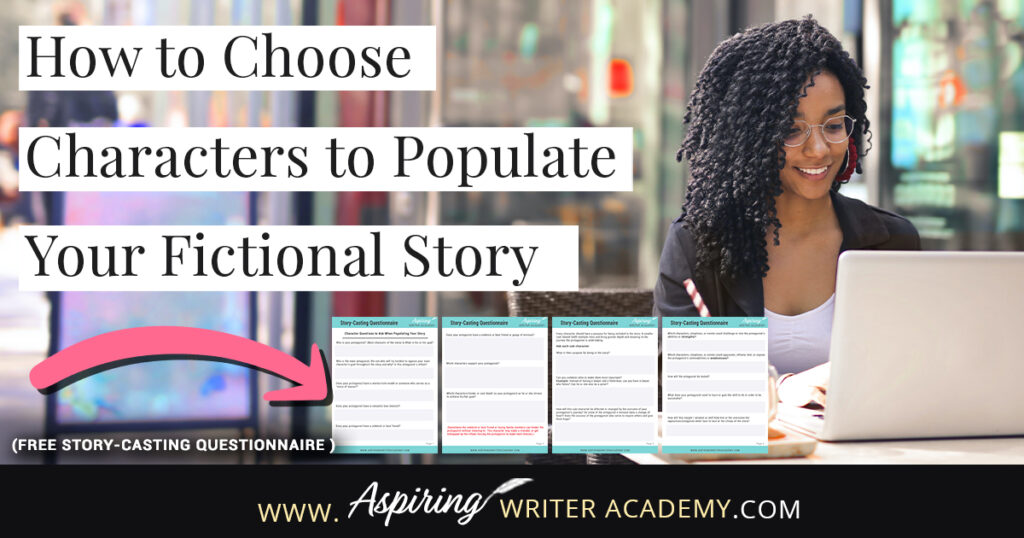
When starting to write a novel, what do you do first? Create characters or a story idea? It’s kind of like the infamous chicken and the egg question. Starting either way can be fine. But at some point, you need to figure out—who are going to be the characters in this story?
In How to Choose Characters to Populate Your Fictional Story, we discuss the different roles characters can play to create a story readers will love. Free Story-Casting Questionnaire included.
Different Types of Fictional Characters & the Roles They Play
Protagonist: This is your main character, the one your story is about. This character takes action to solve a problem or achieve a specific goal. He has his strengths and weaknesses tested as he goes on the story journey. This character has the most to lose if he fails, the most to gain if he wins, and will be the character most changed by the story’s end. His actions & reactions drive the story forward and illustrate the story’s theme.
Antagonist / Villain: This character, motivated by compelling reasons of his own, will take decisive action to stop the main character from achieving his story goal.
Special Note: The antagonist, whether it is another person, or a threatening force of nature, disease, disability, or invisible foe within the main character’s own mind, is the opposition the protagonist will be fighting against throughout the course of the entire story.
A force of nature like an approaching tornado or a health ailment will keep causing troublesome complications and escalate conflict for your protagonist the same as an antagonistic character would until there is a climax and resolution at the story’s end.
What is the difference between an antagonist and a villain?
A person who directly opposes the main character’s goal and causes him the most trouble is called the ANTAGONIST. There may be more than one in a story, but it is important to remember that an antagonist does not have to be an evil villain or even a bad guy. You may have two people with opposing views who each have a valid reason for believing what they do. Maybe they are just fighting over the same thing, like two dogs over a bone. It doesn’t necessarily mean either one of them are wrong, but they cause trouble / conflict for each other. Opposition.
Then there are antagonists who are VILLAINS. Evil. This type of character wants to stop the heroic main character from achieving his goals at any cost. He may intentionally cause harm to your protagonist and use nefarious means to gain the upper hand, perhaps even hurting others in the process. This character is immoral, despicable, and dangerous.
Sub-Characters: The purpose of sub-characters is to either support or hinder the main character from achieving their primary story-worthy goal. They can be encouragers or doubters, an asset or a liability. They can also fill some of the character roles listed below:
Mentor / Role Model: This character is someone who teaches or serves as a role model for your main character. A wise mentor who shares knowledge or offers advice. The voice of reason for your main character. Many times, the mentor will die or be taken away from the protagonist at the midpoint of the story, forcing him to use what he’s learned and continue the rest of the journey alone.
Romantic Love Interest: In a romance, it’s possible the love interest can be the antagonist. There must be a source of relationship conflict between them, perhaps triggered by opposing goals or beliefs. The romantic couple must resolve their differences in order to earn a happily-ever-after by story’s end.
Or the romantic interest may be a character who helps the protagonist overcome the opposition or defeat the villain. The couple should still have a relationship conflict between them that needs to be worked out. And the romantic interest may have a compelling reason of his own to join up with the protagonist and defeat the antagonist/villain. It could be that the antagonist/villain is threatening this character too. They share a common interest in overcoming this foe.
The romantic interest could also just be your protagonist’s biggest supporter, depending on the type of story you are writing. This character could also be someone the protagonist initially dislikes but because of their mutual need to defeat the antagonist, they join forces and their feelings toward one another change.
Sidekick / Best Friend: This is a “window” character, one who the main character talks to, giving the reader insight into the main character’s thoughts and emotions. This character supports the main character and helps them achieve their goal. The best friend usually doesn’t have the same strengths and wisdom as the main character but may have other attributes that are invaluable. The sidekick or best friend can also act as a mentor or voice of reason for your main character.
Antagonist’s Minions: The antagonist should also have a sidekick or best friend or gang of minions who support and help him to achieve his goal of opposing the protagonist. These minor characters may rise up to instill doubt in the main character or help the antagonist cause trouble. Minions can also be a “window” character for the antagonist so the reader can gain insight into his thought process, motivations, and emotions.
Jesters:
Depending on the type of story you want to tell, you might consider adding a humorous character into your cast to lighten the mood between some of the more serious scenes. This comical character can be a child, a clumsy best friend, an odd family member, or perhaps even the love interest.
This character does not have to be comical in every scene and can have serious moments too, or you can have a twist where this comical character actually turns out to be the villain or someone the reader did not expect.
Nurturers & Protectors: Individuals who are caring and nurturing to your protagonist can be endearing as well as protectors, who will defend your main character and their interests.
Note: Look at your main character’s needs and goals and consider the ideas that you have for your story plot to see who your cast should include. Which other types of characters would best serve this story?
Theme Reinforcers:
You may also choose to include a few other characters in your story who represent the theme of your story. The main character’s primary story goal forms the theme. What is your character trying to do? What does this say about him or the issue at hand? What is the message that the character’s journey will say to your reader?
The sub-character’s goal or story journey may “mirror” your protagonist’s goal or journey. Or it may show a different facet or side of the theme, like a multi-faceted diamond.
Example: If your story is about trust or forgiveness or redemption, how many ways can this be played out or shown by different characters in this story? How many ways are there to seek justice? How many opinions or views are there on the correct way to parent a child?
Also ask: Why is it so important that your main character achieve his goal? What are the stakes?
You may want to include a character (no matter how briefly) who represents failure of the main character’s goal. Perhaps this character had a similar goal, but made the wrong choices, took the wrong path, didn’t gain the needed capabilities, and they failed! This shows the main character all they have to lose if they too fail.
This glimpse motivates the main character to continue forward with new strength to achieve their goal.
The main character should also gain a glimpse of what they could gain if they win. They may see a character (a sub-character or just a glimpse of another character on the street) who is trying to achieve a similar goal and they have a win, they achieve the goal and find success! This motivates the main character to continue on, believing success is also possible for him.
One who represents failure
One who represents success
For those familiar with the term Pinch Points, the first would occur in the middle of the first half of the book to pull on the heartstrings, give the heart an emotional “pinch” or squeeze. And the second would occur halfway through the second half of the book. Both serve to create urgency and remind the main character—“Keep going! Don’t give up!”
Other motivating sub-characters you may consider are additional family and friends who either help or hinder the main character.
Perhaps if a family member has an illness, this is the prime motivator behind the determination for your protagonist to succeed. Perhaps the main character needs medical help for their beloved mother or sister or father. Or perhaps the reason the protagonist is going on this journey is for the sake of a child or a friend, who needs their help. Maybe the protagonist wants to protect a family legacy.
Or if the protagonist starts out on the story journey solely for their own purposes, perhaps their goal to succeed is strengthened as the fate of others becomes intertwined with their own failures and successes. Perhaps by the story’s climax the fate of a whole town is riding on the protagonist’s ability to achieve his goal. Now, whether the protagonist wins or loses means so much more!
Who is your protagonist? (Main character of the story) & What is his goal?
Who is the main antagonist, the one who will try hardest to oppose your main character’s goal throughout the story and why? Is this antagonist a villain?
Does your protagonist have a mentor/role model or someone who serves as a “voice of reason?”
Does your protagonist have a romantic love interest?
Does your protagonist have a sidekick or best friend?
Does your antagonist have a sidekick or best friend or group of minions?
Who supports your protagonist?
Who hinders or casts doubt on your protagonist as he strives to achieve his goal?
(Sometimes the sidekick or best friend or loving family members can hinder the protagonist without meaning to. This character may make a mistake, or get kidnapped by the villain, forcing the protagonist to make hard choices.)
Every character should have a purpose for being included in the story. A smaller cast should fulfill multiple roles and bring greater depth and meaning to the journey the protagonist is undertaking.
Ask each sub-character:
What is their purpose for being in the story?
Can you combine roles to make them more important? Example: Instead of having a lawyer and a fisherman, can you have a lawyer who fishes? Can he also be a jester?
How will this sub-character be affected or changed by the outcome of your protagonist’s journey? Do some of the antagonist’s minions have a change of heart? Does the success of the protagonist also serve to inspire others and give them hope?
Which characters, situations, or events could challenge or test the protagonist’s abilities or strengths?
Which characters, situations, or events could aggravate, inflame, test, or expose the protagonist’s vulnerabilities or weaknesses?
How will the antagonist be tested?
What does your protagonist need to learn or gain the skill to do in order to be successful?
How will this insight / wisdom or skill help him overcome the opposition/antagonist when face to face at the climax of the story?
How will others (sub-characters) in the story be changed by the outcome of the story?
We hope you have enjoyed How to Choose Characters to Populate Your Fictional Story, and that you have gained some valuable tips to create believable characters who take on various roles to drive the story forward, build conflict, and reveal the story theme.
If you would like additional help developing your story idea, we invite you to download our Free Brainstorming Your Story Idea Worksheet.
If you have any questions or would like to leave a comment below, we would love to hear from you!
Do you find it difficult to create compelling antagonists and villains for your stories? Do your villains feel cartoonish and unbelievable? Do they lack motivation or a specific game plan? Discover the secrets to crafting villains that will stick with your readers long after they finish your story, with our How to Create Antagonists & Villains Workbook.
This 32-page instructional workbook is packed with valuable fill-in-the-blank templates and practical advice to help you create memorable and effective antagonists and villains. Whether you're a seasoned writer or just starting out, this workbook will take your writing to the next level.
Our Goal for Aspiring Writer Academy is to help people learn how to write quality fiction, teach them to publish and promote their work, and to give them the necessary tools to pursue a writing career.

ENTER YOUR EMAIL BELOW
TO GET YOUR FREE
"Brainstorming Your Story Idea Worksheet"
7 easy fill-in-the-blank pages,
+ 2 bonus pages filled with additional story examples.
A valuable tool to develop story plots again and again.
Other Blog Posts You May Like
Fiction Writing: Critique Group Etiquette & Warning Signs of a Good Group Gone Bad
How to Prep for NaNoWriMo (National Novel Writing Month)
Fiction Writing: How to Plot a Story where the Antagonist is an ‘Invisible Foe’
What Authors Need to Know About ISBN Numbers Before Self-Publishing
Fiction Writing: How to Find a Critique Partner/Group
How to Research Information for a Historical Novel
7 Steps to Begin Writing a New Fictional Story
Learn to Plot Fiction Writing Series: Story Analysis of the movie “Signs”
Fiction Writing: How to Get a Literary Agent
How Writing Prompts Can Improve Your Fictional Story
Creative Writing: 5 Ways to Strengthen a Weak Fictional Character
Fiction Writing: Create a Storyboard to Map Out Your Scenes
Fiction Writing: How Specific Details Can Bring Your Setting to Life
How to Spot Publishing Scams & How To Avoid Them
5 Common Mistakes New Writers Make
Fiction Writing: Story Analysis of the movie “Passengers”
Fiction Writing: How to Write Compelling Dialogue
Fiction Writing: 5 Key Differences Between a Novel and a Novella
Pros & Cons of Traditional vs. Self-Publishing Fiction
Scene & Sequel: The Secret to Plotting an Epic Novel
Scene & Sequel: The Secret to Plotting an Epic Novel (Part 2)

is a multi-published author, speaker, and writing coach. She writes sweet contemporary, inspirational, and historical romance and loves teaching aspiring writers how to write quality fiction. Read her inspiring story of how she published her first book and launched a successful writing career.

